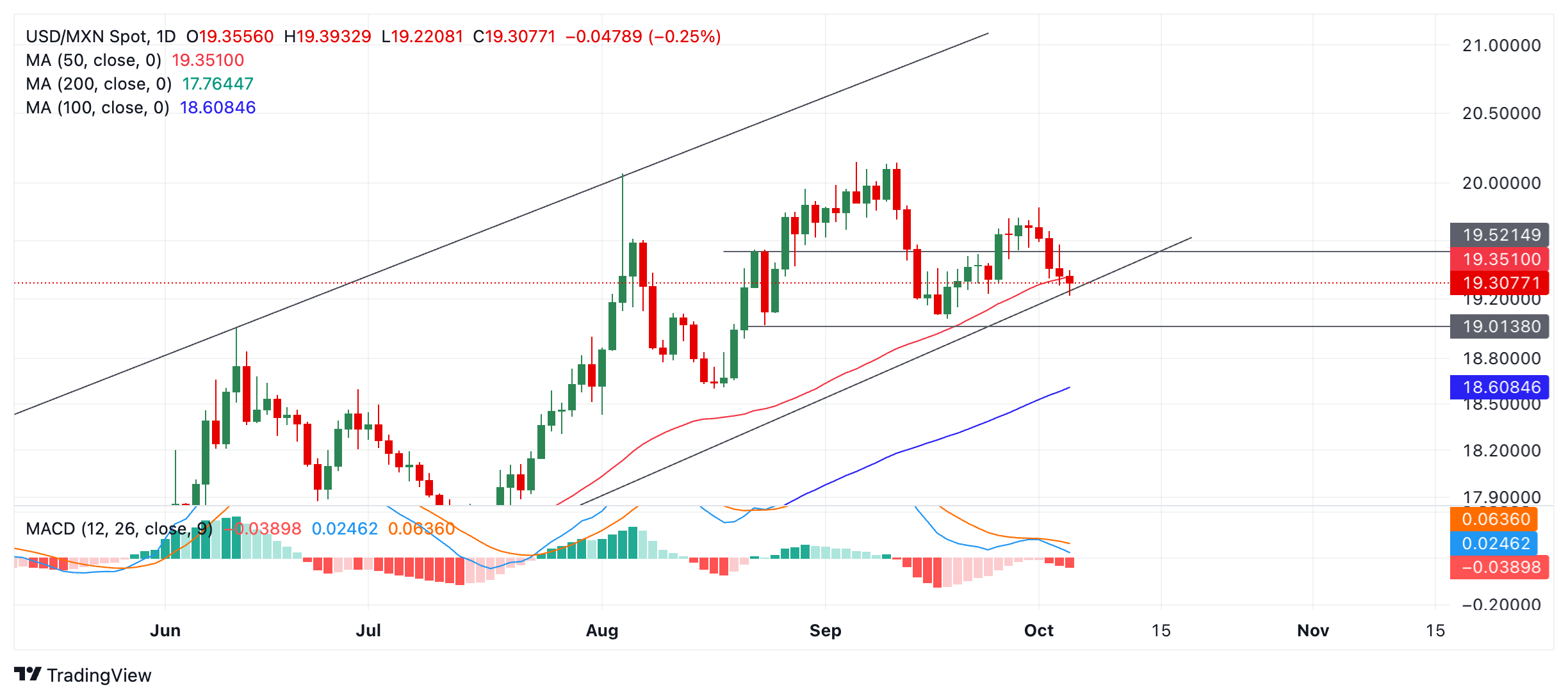- The Mexican Peso reverses earlier gains against the Dollar after US Nonfarm Payrolls roundly beats expectations.
- Earlier the Peso had made gains after the Supreme Court voted to re-examine controversial judicial reforms.
- USD/MXN meets critical support at the base of its rising channel and the 50-day SMA.
The Mexican Peso (MXN) loses some of its earlier gains against the US Dollar (USD) on Friday following the release of the US Nonfarm Payrolls (NFP) report, the most significant labor market release for the United States (US). The report showed an improvement in almost all employment metrics, including payrolls, the Unemployment Rate and Average Hourly Earnings.
The US Bureau of Labor Statistics (BLS) Nonfarm Payrolls (NFP) report showed a rise of 254K new employees joined the US workforce in September, higher than the upwardly-revised 159K in August, and above estimates of 140K.
The US Unemployment Rate, meanwhile, fell to 4.1%, which was below the 4.2% of August, and the 4.2% expected.
Average Hourly Earnings in the US rose 4.0% annually from a revised-up 3.9% in August and was above expectations of 3.8%.
On a monthly basis Average Hourly Earnings fell to plus 0.4% from the upwardly-revised 0.5% MoM in August and was above the 0.3% forecast by economists.
The data indicated the US labor market is in much better shape than expected and means the Federal Reserve (Fed) is less likely to implement a double-dose 50 basis points (bps) (0.5%) rate cut at the November meeting. This in turn, is positive for the US Dollar since the maintenance of elevated interest rates results in higher foreign capital inflows and more demand for USD.
Mexican Peso strengthens then weakens against USD
The Mexican Peso has risen for most of the week, however. Initial gains came on the back of comments from the Deputy Governor of the Bank of Mexico (Banxico) Jonathan Heath, who said on Tuesday that interest rates should remain higher for “more time”. Higher interest rates encourage more foreign capital inflows and strengthen the Peso. Later in the week, news of a Supreme Court decision to review and potentially revise controversial reforms to the judiciary encouraged a continuation of the rally.
Mexican Peso appreciates following Supreme Court motion
The Peso rallied on Thursday after the news that Mexico's 11 Supreme Court judges voted by a majority of eight to three to re-examine controversial constitutional reforms to the judiciary, passed by the government in September. The move could block the implementation of the reforms, which seek to have judges elected rather than appointed, according to El Financiero.
Mexican financial markets took a beating in June after the election of the Morena-led government amid investor concerns regarding these and other proposed reforms. They were a contributing factor in a 10% depreciation of the Mexican Peso. Critics argue that they threatened the independence of the judiciary, were anti-democratic, and endangered outside investment.
The new laws, which were voted in by the Mexican Parliament in September, remain a risk to Mexican assets including the Peso, as highlighted by advisory service Capital Economics in a recent note:
“At the moment, Mexico has an investment grade rating from all three major rating agencies and we doubt this will change in the near-term,” wrote Kimberley Sperrfechter, Emerging Markets Economist at Capital Economics, adding, “That said, if the judicial reform leads to a significant deterioration in the quality of institutions and weaker growth and fiscal policy isn’t tightened sufficiently, there is a risk that Mexico is downgraded in the medium-term.”
The decision to have the reforms re-examined has been spear-headed by Supreme Court Judge Juan Luis González Alcántara. It rests on the legal principle that the new laws risk undermining the independence of Mexico’s judiciary.
Whilst the Supreme Court does not have the power to annul the laws, it can decide whether they need to be revised. Morena’s Head of the Government of Mexico City, Marti Luis Batres, described the move as a “coup d’etat”.
Technical Analysis: USD/MXN falls to 50-day Moving Average
USD/MXN falls all the way down to the base of its rising channel and the level of the 50-day Simple Moving Average (SMA) – a key line in the sand for traders.
USD/MXN Daily Chart
USD/MXN is expected to find support at this level, and there is a chance it will rebound and start moving higher within the range again. The medium and longer-term trends are now bullish, and given the technical analysis principle that “the trend is your friend,” the odds favor a recovery and continuation higher.
That said, the short-term trend is bearish, and the GBP/MXN cross has broken below its rising channel already, which can sometimes be a “canary in the coalmine” warning for other Peso pairs.
A decisive break below the channel and the 50-day SMA, therefore, risks threatening the medium-term uptrend in the USD/MXN. Such a move would be characterized by a longer-than-average bearish candlestick that pierced cleanly below both the channel line and the SMA, and closed near its low. Such a break would clear the way for losses, first down to 19.00 (August 23 low, round number) and then 18.60, the level of the 100-day SMA.
Economic Indicator
Nonfarm Payrolls
The Nonfarm Payrolls release presents the number of new jobs created in the US during the previous month in all non-agricultural businesses; it is released by the US Bureau of Labor Statistics (BLS). The monthly changes in payrolls can be extremely volatile. The number is also subject to strong reviews, which can also trigger volatility in the Forex board. Generally speaking, a high reading is seen as bullish for the US Dollar (USD), while a low reading is seen as bearish, although previous months' reviews and the Unemployment Rate are as relevant as the headline figure. The market's reaction, therefore, depends on how the market assesses all the data contained in the BLS report as a whole.
Read more.Last release: Fri Oct 04, 2024 12:30
Frequency: Monthly
Actual: 254K
Consensus: 140K
Previous: 142K
Source: US Bureau of Labor Statistics
America’s monthly jobs report is considered the most important economic indicator for forex traders. Released on the first Friday following the reported month, the change in the number of positions is closely correlated with the overall performance of the economy and is monitored by policymakers. Full employment is one of the Federal Reserve’s mandates and it considers developments in the labor market when setting its policies, thus impacting currencies. Despite several leading indicators shaping estimates, Nonfarm Payrolls tend to surprise markets and trigger substantial volatility. Actual figures beating the consensus tend to be USD bullish.
Information on these pages contains forward-looking statements that involve risks and uncertainties. Markets and instruments profiled on this page are for informational purposes only and should not in any way come across as a recommendation to buy or sell in these assets. You should do your own thorough research before making any investment decisions. FXStreet does not in any way guarantee that this information is free from mistakes, errors, or material misstatements. It also does not guarantee that this information is of a timely nature. Investing in Open Markets involves a great deal of risk, including the loss of all or a portion of your investment, as well as emotional distress. All risks, losses and costs associated with investing, including total loss of principal, are your responsibility. The views and opinions expressed in this article are those of the authors and do not necessarily reflect the official policy or position of FXStreet nor its advertisers. The author will not be held responsible for information that is found at the end of links posted on this page.
If not otherwise explicitly mentioned in the body of the article, at the time of writing, the author has no position in any stock mentioned in this article and no business relationship with any company mentioned. The author has not received compensation for writing this article, other than from FXStreet.
FXStreet and the author do not provide personalized recommendations. The author makes no representations as to the accuracy, completeness, or suitability of this information. FXStreet and the author will not be liable for any errors, omissions or any losses, injuries or damages arising from this information and its display or use. Errors and omissions excepted.
The author and FXStreet are not registered investment advisors and nothing in this article is intended to be investment advice.
Recommended content
Editors’ Picks

EUR/USD clings to recovery gains near 1.0950 on US Dollar weakness
EUR/USD is holding onto recovery gains near 1.0850 in European trading on Tuesday amid a broadly weaker US Dollar. The recovery in risk sentiment undermines the havem demand for the US Dollar, lifting the pair. Dovish Fed expectations also weigh negatively on the Greenback. Tariff updates eyed.

GBP/USD pares back gains toward 1.2750
GBP/USD is paring back gains to revisit 1.2750 in Tuesday's European session. The pair draws support from renewed US Dollar weakness and a positive shift in risk sentiment but US President Trump's tariff war and global growth concerns limit its upside.

Gold bounces back above $3,000 as trade war tensions flair up
Gold price is bouncing higher in tandem with Equities after another stellar nosedive move on Monday. The precious metal trades just above the $3,000 mark at the time of writing on Tuesday. The bounce is supported by a technical element on the one hand and a geopolitical driver on the other.

XRP battles tariff turbulence amid MVRV buy signal
Ripple seeks stability in a volatile crypto landscape influenced by macroeconomic factors, including reciprocal tariffs. The international money transfer token hit a low of $1.64 on Monday after opening the week at $1.92, representing a 14.5% daily drop.

Strategic implications of “Liberation Day”
Liberation Day in the United States came with extremely protectionist and inward-looking tariff policy aimed at just about all U.S. trading partners. In this report, we outline some of the more strategic implications of Liberation Day and developments we will be paying close attention to going forward.

The Best brokers to trade EUR/USD
SPONSORED Discover the top brokers for trading EUR/USD in 2025. Our list features brokers with competitive spreads, fast execution, and powerful platforms. Whether you're a beginner or an expert, find the right partner to navigate the dynamic Forex market.




